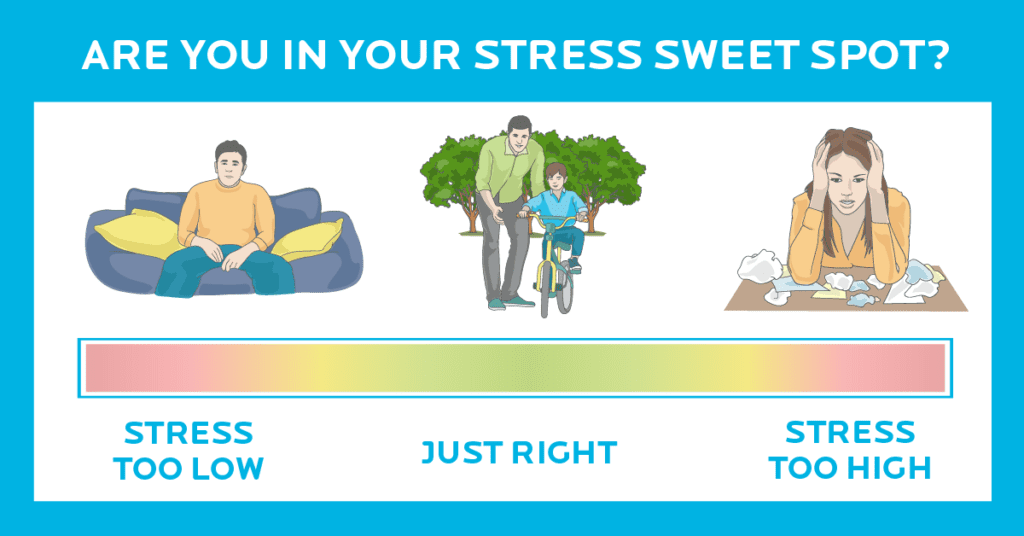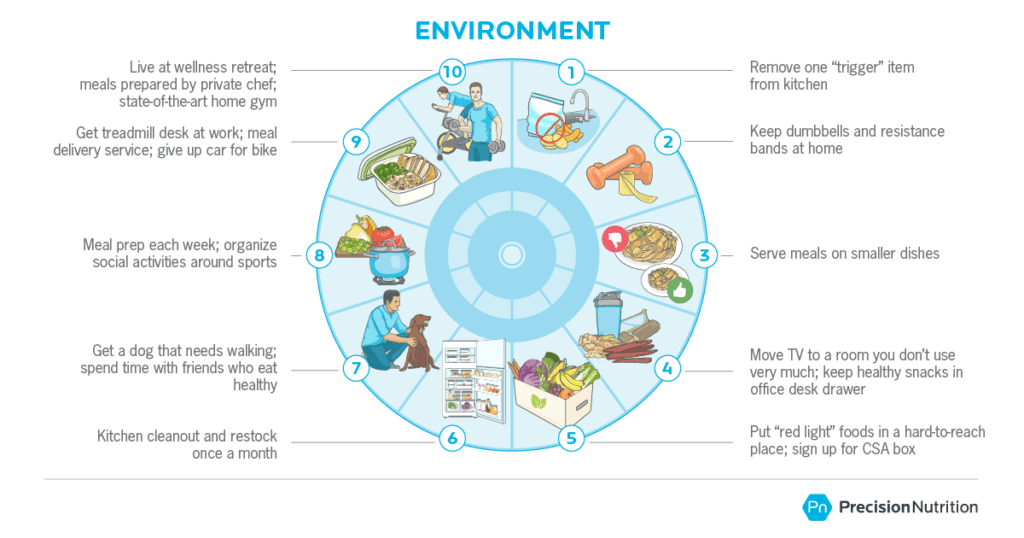“Everything in my life is hot garbage.”
Okay, sometimes it sure feels that way.
But objectively speaking, it’s just not true.
Statements like, “My entire life sucks” or “I’m never going to be happy” have a name: Cognitive distortions.
Or, thoughts that feel true, but aren’t.
If you have thoughts like this, it doesn’t mean anything is wrong with you.
Cognitive distortions just reflect how the quirky human brain works. Our highly-evolved (and woefully error-prone) brains naturally tend to:
- Over-focus on perceived threats and negativity
- Make judgments with only partial information
- Over-generalize, taking facts about a single, specific situation and applying them to everything
(Anyone else raising their hand in recognition?)
However:
While normal, cognitive distortions create a TON of—often unnecessary—stress.
If you often feel annoyed, anxious, or stubbornly pessimistic, you’re probably mired in these kinds of thoughts.
This is actually good news.
Why?
Because it probably means your life isn’t 100 percent hot garbage. Your thoughts just need some adjusting.
(Most people feel a tremendous amount of relief when they discover this.)
In this article, we’ll describe 11 cognitive distortions that humans tend to get stuck in. This list was developed by David Burns, MD, psychiatrist, pioneer of cognitive behavioral therapy, Stanford University professor, and author of the best-selling books Feeling Good and Feeling Great.
Read through the list, and see if you relate to any of these thought types.
Being aware of your thought distortions helps you see your circumstances more clearly and realistically, helping you reduce stress and feel better.
Keep an open mind, and let’s go.
11 cognitive distortions that’ll make you feel like you’re doomed (even when you’re not)
You can read through this list, or better yet, pull a specific thought—preferably one that causes you distress—from your own brain to analyze as you go.
Does your thought fit into any of the below categories? How do you feel once you learn that?
(For a printable, shareable, condensed PDF version of this list, check out: Checklist of common cognitive distortions)
1. All-or-nothing thinking
You see things as all-or-nothing, either-or, usually in extremes (like “perfect” or “horrible”). There are no options between those two categories (like “okay” or “reasonably good”).
For example, unless you follow a diet or workout perfectly, 100 percent of the time, you’ve failed. Call it the “I ate one spoonful of ice cream so I might as well give up on healthy eating” effect.
Examples of all-or-nothing thinking:
- “I missed my deadline on one assignment… I’m going to get fired!”
- “I skipped a workout this week. I’m going to lose all my gains.”
- “I tripped over my words at one point—my whole presentation is ruined!”
2. Overgeneralization
You view a single, negative event as a continuing and never-ending pattern of defeat by using words like, “always” and “never.”
You likely also discount other—possibly conflicting—pieces of evidence and make sweeping conclusions based on one piece of information.
Examples of overgeneralization:
- “I sprained my ankle while I was running. I’ll never run properly again.”
- “I forgot we had a coaching appointment. I’m always letting people down!”
- (When stood up on a date) “I’m always getting rejected! I’ll never find love!”
3. Negative mental filter
You highlight and dwell mostly on the negatives and generally ignore the positives.
Like one drop of ink that colors a whole jar of water dark, or an unwashed tuna can that stinks up your whole kitchen, your overall impression of reality becomes very unfavorable.
Examples of negative mental filter:
- “My workouts have been consistent and I’m recovering pretty well. Only, I still can’t seem to do a single chin-up… I can’t be strong with noodle arms!”
- “I cooked this beautiful meal and it actually tasted good! Of course, my toddler hated the green bits so I definitely won’t be making that again.”
- “Everyone said they liked my performance, but I saw that one audience member grimace when I said one of my lines. I must’ve been terrible.”
4. Discounting the positives
You insist your achievements or positive efforts “don’t count.”
This is particularly painful because even when things in life are going well, you don’t really let yourself enjoy it.
Examples of discounting the positives:
- “Sure, I managed to practice my new walking habit pretty consistently, but—pfft—even my dog can do that.”
- “My coach is only telling me I did a good job this week because she’s trying to be nice.”
- “I spent some time organizing my kitchen, but who cares? There’s still Cheerios under the couch and peanut butter handprints on the walls.”
5. Jumping to conclusions
You assume things are going badly without facts to support this.
There are two subtypes of jumping to conclusions:
▶ Mind-reading: You imagine what other people are thinking, often assuming that people are reacting negatively to you.
Examples of mind-reading:
- “Look at me fumbling around with these exercise bands. Ugh, everyone must think I’m such a boob.”
- “When I told my coach all the stuff that’s been going on in my life lately, I know he must’ve thought I was such a screw-up.”
- “I decided to dress up a bit but I bet everyone at work thought I looked like a pathetic try-hard.”
▶ Fortune-telling: You predict things will turn out badly—without having evidence to support this.
Examples of fortune-telling:
- “I’m never going to get better.”
- “I studied hard, but I just know I’m going to blow this exam.”
- “I’m destined to be an unmotivated sloth who sleeps on their parents’ lumpy basement futon forever.”
6. Magnification or minimization
You blow problems or imperfections way out of proportion, or minimize your successes or admirable qualities.
When you consider other people, you might do the opposite: Emphasizing their favorable aspects and brushing aside their flaws. When you compare yourself, you always come up short.
Examples of magnification and minimization:
- “All the other people in this class seem to be following the choreography but I keep making mistakes.”
- “Everyone else has their eating and exercise all figured out. I’m a hot mess.”
- “My sister can pull off the disheveled mom look and still look cute, but if I so much as have a wrinkle in my shirt, I look like a zombie.”
7. Emotional reasoning
You base your account of reality on your feelings: “I feel bad, so I must be bad.”
This is the extreme end of “going with your gut,” where you don’t consider perspectives or evidence other than your own feelings.
Examples of emotional reasoning:
- “Swinging kettlebells looks super scary and intimidating. It has to be dangerous.”
- “Learning how to cook just feels so overwhelming, so it must be really hard.”
- “I feel so insecure. I must be a loser.”
8. “Mustabatory thinking” or “Shoulding all over yourself”
You torture yourself or other people with “musts,” “shoulds,” “oughts,” and “have tos.”
Instead of identifying your own deeper values and following your “inner compass” of principles or truths, you focus on a set of external (often imagined) obligations, duties, and “rules.”
Always wishing that things were different by some imaginary arbitrary standard, you make yourself feel guilty and frustrated, and others feel defensive and unappreciated.
Plus, you’re always exhausting yourself swimming upstream against the tide of how things really are.
Although “shoulds” are usually meant to motivate yourself (“I should go to the gym”) and others (“You should take my advice”), they usually do the opposite, provoking rebellion and resistance.
Examples of “mustabatory thinking” and “shoulding”:
- “People who care about nutrition shouldn’t eat cookies.”
- “Fit people ought to look like _____ or do _____.”
- “I have to drink—it’s what fun people do!”
9. Labeling
Instead of saying “I made a mistake,” you apply a global label to yourself and say, “I’m an idiot” or “I’m a loser.”
When you (or others) make mistakes, you attribute it to a problem with your (or another’s) character, instead of an isolated thought or behavior error.
When you label, you confuse who you are with what you do. This leaves very little room for normal learning curves, missteps, or human imperfections.
Examples of labeling:
- “Did you see that guy run a red light?? What a jerk.”
- “I can’t believe I cried in front of my trainer. I’m such a basket-case.”
- “Ugh, I ate too much pizza. I’m just a worthless, undisciplined failure.”
10. Personalization
You imagine you’re directly responsible for others’ feelings and responses, and take everything as a personal commentary on your value as a human.
However, by assuming everything that goes wrong is because of you, you’re actually more likely to overlook the actual cause of the problem, preventing learning and growth.
Examples of personalization:
- “My kid’s grades are low… I must be a terrible parent.”
- “This diet is driving me nuts… must be because I just don’t have enough willpower.”
- “If I were a better coach, my gym wouldn’t have had to close down.”
11. Blame
You find fault instead of solving the problem.
Just like personalization, blame prevents learning and growth: You’re always pointing a finger at someone or something else, rather than being appropriately accountable for the things you can control, and working to change them.
Examples of blame:
- “I didn’t stick to that exercise program, but only because I had a lousy coach.”
- “I’m having trouble getting my business off the ground. People in my town just don’t seem to care about health and fitness.”
- “I only eat this way because my kids are super picky and won’t even look at a vegetable.”
Notice your thought errors, and feel better
Did you catch yourself thinking thoughts that fell into one (or more) of the above categories?
Us too.
Now that you know these distortions exist (and that they’re normal), the work going forward is to continue to be aware of your thoughts, and notice when they’re distorted.
When your thoughts don’t reflect the complicated sometimes-hard-sometimes-beautiful nature of reality, that’s okay.
So what’s the alternative?
Become aware of your (or your client’s) thought habits.
Keeping a thought journal can be helpful. Sometimes thought distortions are more obvious when we see them written down (or spoken out loud).
If you hear a client saying a distorted thought, try repeating it back to them in a reflection (“So you’re saying if you eat a piece of pizza, you’re a terrible human”) and see if they respond with something like, “Gosh, it sounds so harsh when you say it back!”
You can also try our Cognitive Flexibility Self-Assessment Worksheet. This assesses how well you’re able to think in creative and nuanced ways, and respond effectively to reality.
Recognize realistic thoughts.
Realistic thoughts not only acknowledge complexity, nuance, and uncertainty—but also your own resilience.
Realistic thoughts sound like this:
- “This part of my life is really hard right now, but things will probably change. Plus, there are other things in my life that are going okay.”
- “I do worry that things might go badly, but there’s also a good chance they might turn out alright, especially if I think proactively and plan ahead.”
- “Although I might not like the outcome of X, I can probably deal with it.”
Here’s a more detailed rundown of what realistic thoughts are—and aren’t—to give you a better idea:
| Distorted thoughts are… | Realistic thoughts are… |
|---|---|
| Rigid, often based around made-up “rules”: “Fit people can always bench press their body weight.” |
Flexible and nuanced: “There are many ways to be fit and strong.” |
| Stale, reflecting old beliefs: “I’ve never been a high-energy person; my parents always said I was lazy.” |
Fresh, reflecting the here-and-now: “I’m noticing I have less energy in this moment.” |
| Pervasive, taking one bad thing and extending it to every aspect of your life: “I had trouble falling asleep last night. I’m a terrible sleeper.” |
Specific, keeping events in context: “I had trouble falling asleep after I stayed up watching upsetting news on TV.” |
| Simplistic, with all/none, always/never, and good/bad types of binary thinking: “I was so bad! I ate all the dessert! I can’t stick to a healthy eating plan at all!” |
Nuanced and complex, using a continuum and allowing more than one thing to be true simultaneously: “I ate dessert, and I savored it. It was more than I typically eat, and also not an everyday thing.” |
| Biased, most often towards the negative: “I missed 2 out of 5 planned workouts this week! I suck!” |
Less biased (as all perspectives are partial), trying to be objective as possible and looking at things from many perspectives: “I got to the gym 3 out of 5 times this week! Considering I started at zero workouts, that’s a big improvement!” |
| Imagined, “story”-based: “Everyone in this gym is looking at me and noticing how out of shape I am.” |
Evidence-based and continually tested against reality: “Looking around, no one’s giving me more than a brief glance. Realistically, everyone’s probably focused on their own fitness.” |
Notice how you feel when you think more realistic thoughts.
(Usually, we find this helps folks feel anxious, and more open, curious, and positive about the future.)
This practice of noticing and modifying takes time and practice, but you and your brain can work together.
Like a toddler with a pair of scissors, your brain’s intent isn’t to harm. Even so, it too benefits from wise adult supervision.
If you’re a health and fitness pro…
When your clients are stressed and exhausted, everything else becomes a struggle: going to the gym, choosing healthy foods, and managing cravings.
But with the right tools, you can help your clients overcome obstacles like chronic stress and poor sleep—leading them toward the lasting health transformations they’ve always wanted.
PN’s Level 1 Sleep, Stress Management, and Recovery (SSR) Coaching Certification will give you these tools. And it’ll give you confidence and credibility as a specialized coach who can solve the biggest problems blocking any clients’ progress. (You can enroll now in the SSR Certification at a big discount.)





Share